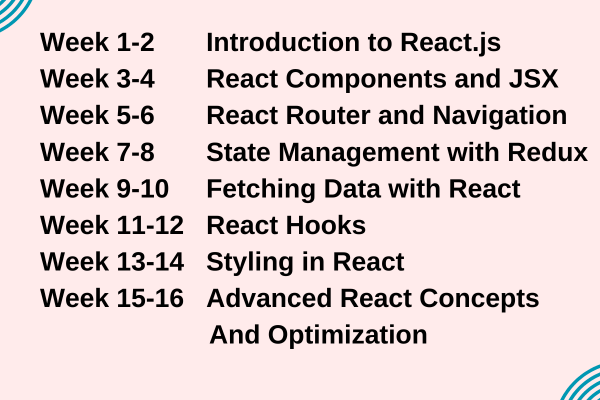Best way to learn react js in 2023

Welcome to our blog post on the best way to learn React.js! This is the right place for you if you want to learn React.js effectively and are excited to dive into it.
Whether you’re a beginner or have some programming experience, we’ve got you covered with a simple and practical approach to learning React.js. In this post, we’ll guide you through the steps and resources that will help you grasp the fundamentals, gain hands-on experience, and build your confidence as a React.js developer.
So, let’s get started on this exciting journey of mastering React.js together!
Here is the best way that you can learn React JS in 2023:
Start with the basics:
Begin by building a strong foundation in JavaScript, the language React.js is built on. Learn about important concepts like variables (used to store data), functions (blocks of reusable code), arrays (to hold multiple values), objects (used to represent real-world entities), and basic control flow (how code is executed in a specific order).
Familiarize yourself with HTML and CSS:
Having a good understanding of HTML (the structure of web pages) and CSS (the language used to style them) will greatly benefit you when creating React components and designing user interfaces. Learn how to create HTML elements and apply CSS styles to make your web pages visually appealing.
Learn React.js fundamentals:
Dive into the core concepts of React.js. Begin by understanding components, which are like building blocks for your application. Learn about props (short for properties), which allow you to pass data between components. Get familiar with state, which helps you manage and update data within a component.
Also, explore lifecycle methods, which are special functions that get called at different stages of a component’s existence. Online tutorials, documentation, and video courses are excellent resources to grasp these fundamental concepts.
Practice with small projects:
Apply what you’ve learned by working on small projects using React.js. Start with simple applications and gradually increase their complexity. This hands-on practice will help solidify your understanding of React.js and improve your problem-solving skills. It’s through practice that you’ll gain confidence and become more comfortable with React.js development.
Explore community resources:
Engage with the React.js community through forums, online communities, and social media platforms. Join discussion groups, ask questions, and share your experiences. Community resources like blogs, tutorials, and open-source projects can provide valuable insights and examples. By connecting with others, you’ll gain different perspectives and learn from the experiences of fellow React.js developers.
Build real-world applications:
Challenge yourself by building larger and more complex React applications. This will give you practical experience in structuring and organizing code, handling data flow between components, and implementing advanced features. Real-world projects will help you understand how React.js is used to create professional and scalable applications.
Read code written by experienced developers:
Study code written by experienced React developers to gain insights into best practices, patterns, and conventions. Analyze open-source projects on platforms like GitHub to see how React.js is utilized in real-world scenarios. Reading code written by experts will help you learn from their techniques and enhance your coding skills.
Stay updated with the React ecosystem:
React.js is a fast-evolving library, so it’s important to stay up-to-date with new features and changes. Follow React.js blogs, attend webinars, and explore online resources to keep up with the latest trends and advancements. By staying informed, you can make the most of the powerful tools and capabilities React.js has to offer.
Take the help of UniKaksha:
As you embark on your journey to learn React.js, consider taking the help of UniKaksha. UniKaksha offers a Full Stack Web Development course where we teach you the basics of Front End Development, Back End Development and help you build database-backed APIs and web applications using ReactJS, NodeJS, and MongoDB. Explore our course today and understand how to be a Full Stack Web Developer.
Now that you have an understanding of how to learn React.js, let’s take it a step further with a comprehensive 16-week guide on mastering React.js.
Below, is a detailed plan that will help you progress systematically and build a strong foundation in React.js over 16 weeks.
16-Week Guide to become a React Js Expert:

Week 1-2: Introduction to React.js
In the first two weeks, focus on gaining an understanding of React.js. Start by reading about the fundamentals of React, including its Virtual DOM and component-based architecture. To begin coding, set up a development environment with Node.js and choose a code editor that suits your preferences. As a beginner, familiarize yourself with basic JavaScript ES6 syntax, such as arrow functions, classes, and modules, to lay the foundation for learning React.js.
Week 3-4: React Components and JSX
During weeks 3 and 4, shift your attention to React components, the building blocks of React applications. Start by learning how to create functional and class components and gain an understanding of their lifecycle methods. Practice writing components using JSX syntax, which combines HTML-like code with JavaScript. Focus on rendering components, passing data through props, and managing component states to build interactive interfaces.
Week 5-6: React Router and Navigation
In weeks 5 and 6, explore client-side routing with React Router. Begin by understanding the importance of navigation within a single-page application. Install and configure React Router in your project, and learn how to set up different types of routes, including dynamic and nested routes. Implement navigation between different sections of your application using React Router.
Week 7-8: State Management with Redux
During weeks 7 and 8, dive into state management with Redux. Begin by understanding the core principles of Redux, including the Redux store, actions, reducers, and middleware. Follow tutorials and examples to practice implementing Redux in your React application. Focus on managing and sharing state across multiple components effectively.
Week 9-10: Fetching Data with React
In weeks 9 and 10, learn how to fetch data from external APIs in React. Explore different methods, such as using the Fetch API or libraries like Axios, to make asynchronous API calls. Understand how to handle asynchronous operations, update the UI with fetched data, and handle errors gracefully. Practice integrating data fetching into your React application.
Week 11-12: React Hooks
Shift your attention to React Hooks during weeks 11 and 12. Start by learning about useState, the most commonly used hook for managing state in functional components. Explore other hooks like useEffect, useContext, and custom hooks to handle side effects, share data between components, and simplify complex logic. Convert existing class components to functional components using hooks.
Week 13-14: Styling in React
In weeks 13 and 14, focus on styling React components. Explore different approaches such as CSS modules, styled-components, or CSS-in-JS libraries to style your React application. Learn about styling patterns and best practices, and apply them to your components. Experiment with different styling techniques to enhance the visual appeal of your application.
Week 15-16: Advanced React Concepts and Optimization
In the final two weeks, explore advanced concepts and optimization techniques in React. Learn about higher-order components (HOCs) and render props, which provide powerful patterns for code reuse and component composition. Dive into performance optimization techniques such as memoization and code splitting to ensure your React application runs efficiently. Familiarize yourself with testing React components using tools like Jest and React Testing Library to ensure your code is reliable and error-free.
We hope this blog post on the best way to learn React.js has provided you with valuable insights and a clear roadmap to begin your journey in mastering this powerful JavaScript library.
Related : Top 7 Advantages of Using React JS in 2023
Remember, learning React.js is a continuous process, so keep practicing, exploring, and expanding your skills. Embrace challenges, seek support from the React.js community, and stay curious. With dedication and perseverance, you’ll be well on your way to becoming a skilled React.js developer.
So, get ready to embark on this exciting journey of mastering React.js and unleash your creativity in building dynamic and interactive web applications.
Happy coding!
About the Author
Luqmaan Shaik serves as the Blog Specialist at Unikaksha, where he leads a team of technical writers dedicated to researching and providing valuable content for blog readers. With a wealth of experience in SEO tools and technologies, his writing interests encompass a wide range of subjects, reflecting the diverse nature of the articles. During his leisure time, he indulges in an equal balance of web content and book consumption.
 Related Posts
Related Posts
|
Offerings
|
FutureFirst
|
SmartStart
|
GradEdge
|
SelfMastery
|
|---|---|---|---|---|
|
Doubt clearing session
|
                                          |
                                          |
                                          |
                                          |
|
No of job opportunities
|
15 | 25 | 15 | 3 |
|
Course Access
|
5 Years | Lifetime | Lifetime | 5 Years |
|
Free Library Courses
|
                                          |
                                          |
                                          |
                                          |
|
Job Assurance
|
                                          |
                                          |
                                          |
                                          |
|
Language
|
English/Hindi | 5 Language options | English/Hindi | English/Hindi |
|
Live classes
|
100% | 100% | 100% |                     |
|
Offline
|
                                          |
                                          |
                                          |
                    |
|
Industry Expert Sessions
|
                    |
                                          |
                    |
                    |
|
Internship (IOP)
|
                                          |
Guaranteed | Guaranteed | Based on evaluation |
|
1:1 Mentoring sessions
|
                    |
                                          |
                    |
                    |
|
Customer Support
|
                                          |
                                          |
                                          |
                                          |
|
Dedicated Program Manager
|
                    |
                                          |
                    |
                    |
|
Opt for Placement services
|
Compulsary |                                           |
                                          |
                                          |
|
Career Support
|
1 Year | 18 Months | 1 Year | 3 Months |
|
Regular assessments
|
                                          |
                                          |
                                          |
                                          |
|
Report cards
|
                                          |
                                          |
                                          |
                    |
|
Career Guidance
|
                                          |
                                          |
                                          |
                    |
|
Certificates
|
                                          |
                                          |
                                          |
                    |
|
Scholarship
|
                                          |
Available | Available |                     |
|
Trial Class
|
1 week | 1 week | 1 week |                     |
|
Outside placement
|
Paid | Allowed | Allowed | Allowed |
|
Premium Jobs
|
                    |
                                          |
                    |
                    |
